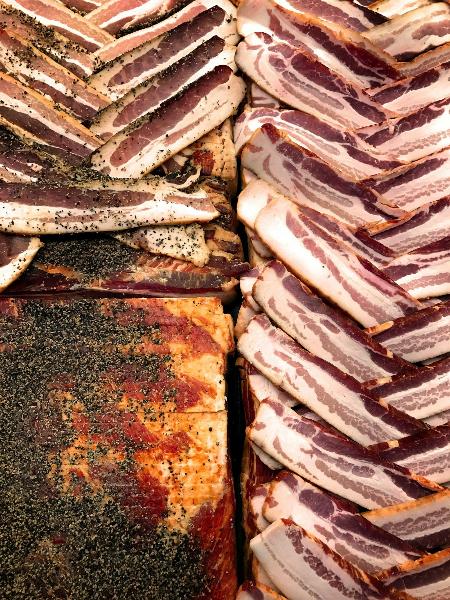The Ultimate Steak Guide: How to Cook, Reverse Sear, Oven Finish, and Reheat Steak for Perfect Results
Share
Steak is one of the most iconic and satisfying meals you can put on your table. Whether you are grilling a thick ribeye on the weekend, reverse searing a New York strip for a special occasion, or simply pan-searing a sirloin on a busy weeknight, steak delivers unbeatable flavor, richness, and comfort.
At Wisconsin River Meats, where we focus on quality and honest Midwestern food traditions, we know steak deserves respect. A good steak is worth the effort, but many people still have questions, including:
-
How do you cook steak perfectly?
-
How do you cook steak in the oven?
-
What is the reverse sear method, and how do you use it?
-
How do you reheat steak without drying it out?
-
How do you cook a ribeye steak the right way?
This in-depth steak guide will cover everything from pan-searing basics to advanced steakhouse techniques, including food safety, seasoning tips, temperature targets, and more. Whether you are a new cook or a seasoned grill master, this comprehensive breakdown will help you get the best results every time you serve steak.

What Makes a Perfect Steak?
Before jumping into cooking methods, let’s talk about what makes a great steak:
-
Good marbling: the thin white streaks of fat running through the meat add flavor and tenderness
-
A thick cut: at least 1 inch thick, ideally 1.5 inches, to help keep the interior juicy
-
Simple seasoning: salt and pepper are often all you need to bring out the beef’s natural flavor
-
Proper cooking technique: high heat for a crust, gentle finishing, and resting to preserve juices
If you start with a high-quality, well-marbled cut from a reputable butcher, you are already halfway to success. At Wisconsin River Meats, we proudly offer premium beef with rich marbling and consistent quality, raised and processed with traditional values.
How to Cook Steak
The most classic way to cook a steak is on the stovetop using a heavy skillet. Cast iron is a favorite because it holds heat well and gives a deep brown crust.
Classic Pan-Seared Steak
-
Remove the steak from the refrigerator 30 to 45 minutes before cooking. Bringing it closer to room temperature helps it cook evenly.
-
Pat the steak dry with paper towels. Moisture on the surface prevents good browning.
-
Season generously with kosher salt and fresh cracked black pepper on both sides.
-
Preheat your skillet over medium-high heat. Add a tablespoon of high smoke point oil, such as avocado or canola oil.
-
Place the steak in the pan and let it sear undisturbed for about 2–3 minutes, until a golden-brown crust forms.
-
Flip and sear the other side for another 2–3 minutes.
-
Reduce the heat to medium, then add a tablespoon of butter, a crushed garlic clove, and fresh thyme or rosemary to the pan. Tilt the pan and spoon the melted butter over the steak repeatedly for extra flavor.
-
Check the temperature with a meat thermometer:
-
Rare: 120–125°F
-
Medium-rare: 130–135°F
-
Medium: 140–145°F
-
-
Rest the steak on a cutting board for 5–10 minutes before slicing. This allows juices to redistribute for a juicy, flavorful bite.
This method works beautifully for ribeye, sirloin, New York strip, and other premium cuts.

How to Cook Steak in the Oven
If you don’t have a grill, the oven is a fantastic tool for cooking steak, especially for thicker cuts. Baking with a brief sear gives you a good crust while keeping the inside tender.
Oven-Finished Steak
-
Preheat your oven to 400°F.
-
Season the steak as usual with salt and pepper.
-
Heat a cast iron skillet over medium-high heat and add a small amount of oil.
-
Sear the steak for 2 minutes on each side to build a crust.
-
Transfer the skillet directly into the oven and cook for another 5 to 8 minutes, depending on the steak’s thickness and your preferred doneness.
-
Check with a thermometer for target temperatures and remove the steak when done.
-
Rest 5–10 minutes before serving.
The oven approach is especially handy when cooking more than one steak at a time, since it provides steady heat to finish cooking after a fast stovetop sear.
What Is the Reverse Sear Method?
Reverse searing is a professional technique that has become more popular among home cooks in recent years. It flips the traditional searing method upside down. Instead of searing first, you slow-cook the steak to just below the target temperature, then finish with a hard sear to develop a perfect crust.
The reverse sear works best for thick steaks at least 1.5 inches thick.
How to Reverse Sear a Steak
-
Preheat your oven to 250°F.
-
Season the steak generously with salt and pepper.
-
Place the steak on a wire rack over a baking sheet to allow even air circulation.
-
Cook in the oven until the steak reaches about 10–15 degrees below your desired doneness (for medium-rare, remove it at about 115°F).
-
Heat a cast iron pan on high heat with a bit of oil.
-
Sear the steak for about 45–60 seconds per side until a rich brown crust forms.
-
Rest the steak for 5 minutes before slicing.
Reverse searing gives you incredible edge-to-edge color with precise doneness and a beautifully crisp exterior. Many chefs swear by it for restaurant-quality steak at home.
How to Cook Ribeye Steak
Ribeye is a true classic and arguably one of the best cuts of beef thanks to its abundant marbling, rich flavor, and tender bite. It’s ideal for grilling or pan-searing, but you can also reverse sear a thick ribeye for incredible results.
Stovetop + Oven Ribeye
-
Rest the ribeye at room temperature for 30–45 minutes.
-
Season heavily with salt and pepper. Ribeye can handle bold seasoning.
-
Heat a heavy skillet with a high smoke point oil until shimmering.
-
Sear the ribeye 2–3 minutes per side for a deep crust.
-
Place the skillet in a 400°F oven for 5–7 minutes to finish cooking.
-
Check temperature: aim for 130–135°F for medium-rare.
-
Rest before slicing.
For a true steakhouse finish, spoon melted butter, fresh thyme, and a smashed garlic clove over the ribeye during the final minute of cooking.

Grilling Ribeye Steak
If the weather is nice and you have a grill, ribeye shines over charcoal or gas flames.
-
Preheat your grill to high.
-
Clean and oil the grates to prevent sticking.
-
Place the ribeye over direct heat for 3–4 minutes per side to sear.
-
Move to indirect heat to finish cooking if needed.
-
Rest for 5–10 minutes before slicing.
Ribeye’s marbling means it can tolerate high temperatures without drying out, making it one of the best grilling steaks.
How to Reheat Steak
Leftover steak can be delicious if you know how to reheat it gently. Too much heat can dry it out or make it rubbery.
Best Methods to Reheat Steak
-
Low oven + quick sear: Warm the steak at 250°F on a baking tray until heated through (about 15–20 minutes). Then give it a fast 30-second sear in a hot skillet.
-
Sous vide: Place steak in a sealed bag and heat in a water bath at 130°F for about 30 minutes. Finish with a quick sear if desired.
-
Microwave with caution: Place the steak on a plate with a damp paper towel over the top and microwave at 50% power in short 30-second bursts, checking frequently.
Avoid microwaving on full power, which tends to turn steak tough and chewy.
Best Seasonings for Steak
While salt and pepper alone can make a wonderful steak, you can also try these classic flavor pairings:
-
Garlic and rosemary
-
Crushed peppercorn and thyme
-
Smoked paprika and a pinch of cayenne
-
Butter with shallots and herbs
-
Worcestershire or soy sauce–based marinades
A compound butter made with herbs, garlic, and lemon zest can elevate your steak beautifully, melting on top just before serving.

Steak Temperatures and Doneness
Learning to measure steak temperature accurately is the key to perfect results:
-
Rare: 120–125°F (deep red center)
-
Medium-rare: 130–135°F (warm red center, slightly pink)
-
Medium: 140–145°F (pink center)
-
Medium-well: 150–155°F (mostly gray-brown with slight pink)
-
Well-done: 160°F+ (fully brown, little juice left)
Most steak lovers agree medium-rare is the sweet spot for tenderness and flavor.
Best Side Dishes for Steak
Steak deserves great company on the plate. Here are classic and crowd-pleasing pairings:
-
Roasted garlic mashed potatoes
-
Baked potatoes with sour cream
-
Sautéed mushrooms with thyme
-
Creamed spinach
-
Grilled asparagus
-
Caesar salad
-
Dinner rolls with butter
A bold red wine, such as cabernet sauvignon or malbec, makes a perfect match for a rich steak dinner.
Mistakes to Avoid When Cooking Steak
-
Overcooking: the number one mistake. Always use a thermometer.
-
Skipping the rest: slicing too soon loses all those precious juices.
-
Cooking straight from the fridge: leads to uneven doneness. Let steak warm up first.
-
Crowding the pan: cook one or two steaks at a time for best searing.
-
Low heat: sear with high heat to build that deep crust.
Final Thoughts
Steak is one of life’s greatest pleasures — simple, satisfying, and deeply rooted in traditional Midwestern cooking. When you start with a quality cut and follow a few straightforward steps, you can get restaurant-level results in your own kitchen.
Whether you pan-sear on a busy weeknight, finish in the oven, or try the reverse sear for the ultimate crust, steak is about respecting the ingredients and taking your time to get it right. Ribeye in particular rewards a little care and a confident, hot sear.
And if you have leftovers, remember gentle reheating is your best friend. A low oven and a brief finishing sear bring steak back to its juicy, mouthwatering best.
At Wisconsin River Meats, we are proud to supply premium steaks raised and processed with honesty and tradition. We believe great steak starts with great meat — no shortcuts, no fillers, just the rich flavor of high-quality beef.
If you’d like to explore ribeye, sirloin, or other premium steaks, visit our website or stop by our Mauston shop to see our full selection. We’re always happy to share cooking tips and ideas to make your next steak night something special.

